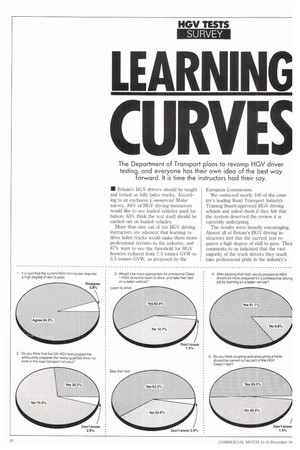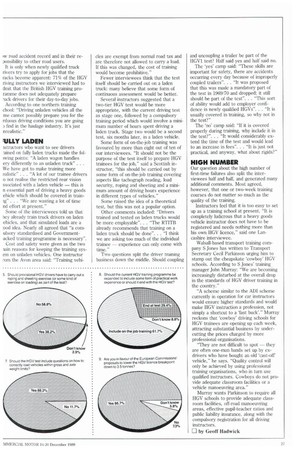LEARN NG
Page 28

Page 29

If you've noticed an error in this article please click here to report it so we can fix it.
CURVES
The Department of Transport plans to revamp HGV driver testing, and everyone has their own idea of the best way forward. It is time the instructors had their say.
• Britain's HGV drivers should be taught and tested on fully laden trucks. Accord
to an exclusive Commercial Motor survey, 84% of HGV driving instructors would like to see loaded vehicles used for tuition; 63% think the test itself should be carried out on loaded vehicles.
More than nine out of ten HGV driving instructors are adament that learning to drive laden trucks would make them more professional recruits to the industry, and 87% want to see the threshold for HGV licences reduced from 7.5 tonnes GVW to 3.5 tonnes GVW, as proposed by the European Commission.
We contacted nearly 100 of the country's leading Road Transport Industry Training Board-approved HGV driving schools and asked them if they felt that the system deserved the review it is currently undergoing.
The results were broadly encouraging. Almost all of Britain's HGV driving instructors feel that the current test requires a high degree of skill to pass. Theit comments to us indicated that the vast majority of the truck drivers they teach take professional pride in the industry's lw road accident record and in their reponsibility to other road users.
It is only when newly qualified truck rivers try to apply for jobs that the racks become apparent: 71% of the HGV riving instructors we interviewed had to dmit that the British HGV training proramrne does not adequately prepare lick drivers for their day-to-day jobs. According to one northern training chool: "Driving unladen vehicles all the me cannot possibly prepare you for the rduous driving conditions you are going it find in the haulage industry. It's just nrealistic."
IULLY LADEN
istructors who want to see drivers rained on fully laden trucks made the folming points: "A laden wagon handles cry differently to an unladen truck" . . . We have got to make training more ealistic" .. . "A lot of our trainee drivers o not realise the restricted rear vision ssociated with a laden vehicle — this is n essential part of driving a heavy goods ehicle which should be covered in train . "We are wasting a lot of time nd effort at present."
Some of the interviewees told us that hey already train truck drivers on laden ehicles, and that simulated loads are a ood idea. Nearly all agreed that "a cornulsory standardised and Governmentacked training programme is necessary". Cost and safety were Oven as the two lain reasons for keeping the training sysem on unladen vehicles. One instructor rom the Avon area said: "Training vehi des are exempt from normal road tax and are therefore not allowed to carry a load. If this was changed, the cost of training would become prohibitive."
Fewer interviewees think that the test itself should be carried out on a laden truck: many believe that some form of continuous assessment would be better.
Several instructors suggested that a two-tier HGV test would be more appropriate, with the current driving test as stage one, followed by a compulsory training period which would involve a minimum number of hours spent driving a laden truck. Stage two would be a second test, six months later, in a laden vehicle.
Some form of on-the-job training was favoured by more than eight out of ten of our interviewees. "It should not be the purpose of the test itself to prepare HGV trainees for the job," said a Scottish instructor, this should be carried out by some form of on-the-job training covering aspects like tachograph reading, load security, roping and sheeting and a minimum amount of driving hours experience in different types of vehicles."
Some raised the idea of a theoretical test, but this was not a popular option.
Other comments included: "Drivers trained and tested on laden trucks would be more employable". . . "The RTITB already recommends that training on a laden truck should be done". . "I think we are asking too much of the individual trainee — experience can only come with time."
Two questions split the driver training business down the middle. Should coupling and uncoupling a trailer be part of the HGV1 test? Half said yes and half said no.
The 'yes' camp said: "These skills are important for safety, there are accidents occurring every day because of improperly coupled trailers". . . "It was proposed that this was made a mandatory part of the test in 1969,70 and dropped; it still should he part of the test". . "This sort of ability would add to employer confidence in newly qualified HGVs". . -It is usually covered in training, so why not in the test?"
The 'no' camp said: "If it is covered properly during training, why include it in the test?". . "It would considerably extend the time of the test and would lead to an increase in fees". . . "It is just not practical, and anyway, what about rigids?"
HIGH NUMBER
Our question about the high number of first-time failures also split the interviewees half and half, and generated many additional comments. Most agreed, however, that one or two-week training courses do not matter so much as the quality of the training.
Instructors feel that it is too easy to set up as a training school at present. "It is completely ludicrous that a heavy goods vehicle instructor does not have to be registered and needs nothing more than his own HGV licence," said one Lancashire interviewee.
Walsall-based transport training company S Jones has written to Transport Secretary Cecil Parkinson urging him to stamp out the cheapskate 'cowboy' fIGV schools. According to S Jones' training manager John Murray: "We are becoming increasingly disturbed at the overall drop in the standards of HGV driver training in the country."
"A scheme similar to the AD1 scheme currently in operation for car instructors would ensure higher standards and would make IIGV instruction a profession, not simply a shortcut to a 'fast buck'." Murray reckons that 'cowboy' driving schools for HGV trainees are opening up each week, attracting substantial business by undercutting the prices charged by more professional organisations.
They are not difficult to spot they are often one-man bands set up by exdrivers who have bought an old 'cast-off' vehicle," he says. "Quality control will only be achieved by using professional training organisations, who in turn use qualified instructors. Cowboys do not provide adequate classroom facilities or a vehicle manoeuvring area."
Murray wants Parkinson to require all HGV schools to provide adequate classroom facilities, off-road manoeuvring areas, effective pupil-teacher ratios and public liability insurance, along with the compulsory registration for all driving instructors.
LI by Geoff Hadwiek




































































































